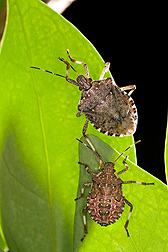Assessment of the Distribution and Natural Enemies of Brown Marmorated Stink Bug in southern Ontario

A research project by Cynthia Scott-Dupree (University of Guelph School of Environmental Science) in conjunction with Hannah Fraser and Tracey Baute of OMAFRA (Ontario Ministry of Food and Rural Affairs) and Tara Gariepy of AAFC (Agriculture and Agri-Food Canada).
Brown marmorated stink bug (BMSB), Halyomorpha halys, is an invasive pest native to South Korea, Japan, Taiwan, and eastern China. While it has yet to be found in Guelph, it has been found in many surrounding cities (see below). The research will help develop a monitoring protocol for BMSB, using sweeps and visual inspection techniques in high-risk crops such as soybeans, corn, tree fruit and other horticultural crops (using other sites in southern Ontario) as well as preferred woody and ornamental hosts (using The Arboretum and other urban parks and botanical gardens in southern Ontario).
Below are some details about the project.
In 2001, BMSB was detected in Pennsylvania, but is believed to have been introduced to the U.S. as early as 1996. It has now been detected in 39 states. BMSB is highly polyphagous and does not require a specific host to facilitate establishment or spread. It exhibits shelter-seeking behaviour in the fall which contributes to widespread distribution in cargo, vehicles and railcars. Since 2010, there have been over 80 confirmed homeowner finds in Hamilton, Burlington, Toronto and Newboro. In August 2012, an established breeding population was identified in Hamilton suggesting that BMSB has been present in Ontario for at least 3 to 4 years. In 2013, detections of BMSB have been confirmed in Windsor and Cedar Springs.
Populations of BMSB tend to become established in urban areas first then disperse to agricultural crops. Tree hosts favour population build-up early in the season, after which BMSB move into agricultural crops. The abundance of suitable landscape hosts and proximity of BMSB populations pose a serious risk to adjacent agricultural areas, including regions of concentrated tree fruit, grape and nursery production located in the Niagara region. The impact on greenhouse (GH) production has not been determined, but the introduction of BMSB to protected culture could be devastating since Ontario GH IPM programs focus primarily on biological control.
BMSB has a broad host range that includes tree fruit, berries, grapes, vegetables, field crops, weeds, ornamental trees and shrubs. Feeding damage by nymphs and adults on vegetative and fruiting plant parts renders the crop unmarketable. Patterns of dispersal are not well understood and contribute to difficulties in managing BMSB. The pest is highly mobile and can readily switch hosts, moving between crops throughout the growing season. In 2010, BMSB was seen in extremely high numbers in the mid-Atlantic region of the U.S., where growers reported significant damage in multiple crops. Despite aggressive use of insecticides, economic losses in apples were estimated at $37 mill and 50% of the peach crop was unmarketable (2010). Horticultural crops at risk in Ontario (fruit, vegetables, nursery ornamentals and GH production) are valued at approximately $1.659 B (2007). Over 2 mill corn and soybean acres are at risk, with a potential $18.4 mill loss from fields in the immediate vicinity of current Ontario infestations, based on preliminary US research.
A number of parasitoids are known to attack BMSB eggs in Asia; however, BMSB has presumably been introduced to North Amlerica without its complement of natural enemies. The potential for attack by native parasitoids has not been fully explored, and limited information is available on the parasitoid complex associated with Pentatomidae in Canada. Baseline data on parasitism, parasitoid species composition, and host range of stink bug parasitoids could provide valuable insight on the potential role of natural enemies in an IPM strategy for BMSB. Availability of these data could expedite the consideration of biological control solutions, which is particularly critical in sensitive urban and natural habitats where pesticide use is prohibited.
Objectives of the study:
- Assessing the distribution and abundance of, and patterns of host use by BMSB in southern Ontario;
- Identifying agricultural areas in southern Ontario at high risk from BMSB;
- Developing an inventory of natural enemies of BMSB that exist in southern Ontario to determine whether endemic parasitoids and predators of indigenous stink bugs can be used to control BMSB; and
- Develop information on BMSB for use in communications including websites, newsletters, tweets/blogs, online tools for IPM and outreach to the general public.